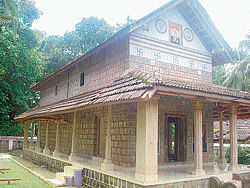Lost in wilderness

On the other hand, the visitors can listen to birds chirping and the sound of water flowing in the river.
The attractive stone building with tile roof draws the attention of any visitor. Along with the idol of Chandranatha Swamy, the presiding deity and the 8th Thirthankara, there are mini idols (Jinabimbas) of 24 Thirthankaras and ‘Kuladevi’ Padmavathi. The Basadi is open between 5.30 am and 7 pm and 5 pm and 8 pm.
Though there are no documents to prove when was this Basadi built, Jain seer Sri Charukeerthi Bhattaraka Swamiji opines that the Basadi must have been built between 12th century and 15th century by wealthiest people of the period. As many as 18 Basadis come under the seer’s jurisdiction and the Chandranatha Swamy Basadi is one among them.
Quite interestingly, 70-year-old Shantha, and mother of Jinendra Jain (who presently performs daily rituals at the Basadi), says that no Jain family lived in the vicinity ever since she came to this place when she was 15. “Its 55 years since I moved to this place after my marriage. My husband was performing the rituals at the Basadi since 1952, the year the Basadi was renovated. After he passed away in 1974, my son Jinendra is performing the rituals even to this day,” she goes down memory lane. The lady who rolls beedies when her son goes for work, is the daughter of Lokanath Shastry, a litterateur who authored books like ‘Venoorina Gatha Vaibhava’ and ‘Jaina Basadigalu’ in the 1930s.
Another interesting factor is that she was told that there were 700 Jain families in the vicinity, but there are none today.
“They would have migrated several decades ago, as there was not even one Jain family when I came to this place 55 years ago,” she says. Jinendra Jain, who performs daily poojas in the Basadi, says that the legal heir of the Basadi, Agari Sripala Shetty, handed over the land to Jinendra’s mother, in 1986. Though Jinendra does not have the documents to prove how old is the Basadi, documents indicate that it was first renovated in 1938 and then in 1952 when the thatched roof of the Basadi was replaced by tile roof.
In 2006, the red oxide floor was converted to mosaic floor. The Basadi has one water container (1868) and a temple bell, both having antique value.
Jinendra works as a postman for the last 30-odd years. In fact, he has not taken a promotion fearing that he may be transferred to other places which in turn may affect temple rituals. Though his home is in a dilapidated condition, he has not taken any steps to repair it. “The Basadi needs some repair works. Unless the Basadi is renovated, how can I repair my home,” he questions.
How to go
If you are travelling from Mangalore to Moodbidre, you will get Ketthikal, about 2 kms from Vamanjoor (which is 12 kms from Mangalore). From Ketthikal, travel further on the highway for about 300 metres. Take left on a narrow road where a board indicating ‘Kolkebail’ is mentioned. In that road, if you travel for about 1.2 kms, you will reach the Basadi. In fact, the road ends at Basadi premises, beyond which Gurpur river flows. Keep left, as there are two diversions on the stretch to the right.
The stretch is too steep, at two to three places and you are tend to get a feeling that you have lost the road (you may hardly get any person on the stretch to make enquiries!). Once you reach the destination, its only you, Lord Chandranatha Swamy and the nature (though there are a few houses, they are at a distance). However, there is mobile network.
Deccan Herald is on WhatsApp Channels| Join now for Breaking News & Editor's Picks